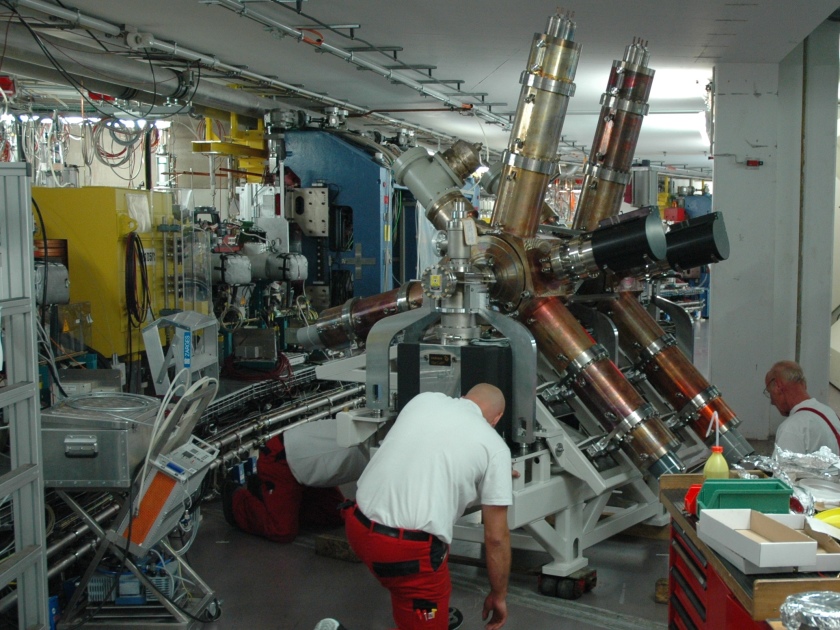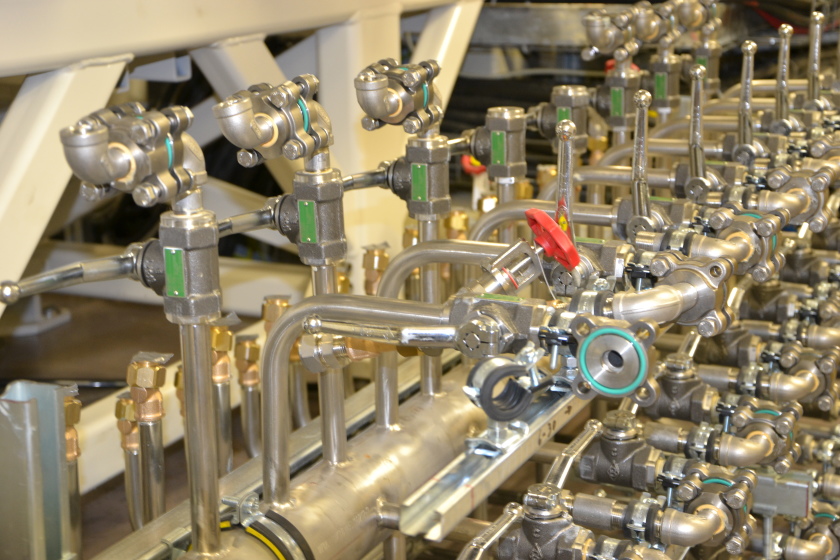New cavities successfully installed

The new cavities during their installation. © C. Jung /HZB

A glimps at the water circuits. © C. Jung / HZB
At the heart of BESSY II are four cavities, hollow resonators, providing the energy that electrons in the storage ring re-absorb after they have released it as light packets. The old cavities were still from the 1970s and were employed at DESY in Hamburg, then at BESSY I, and finally at BESSY II beginning in 1998. “However, the limit of their operating life has been reached”, says Dr. Wolfgang Anders from the HZB Institute of SRF – Science and Technology. Anders, an expert in the field, was responsible for replacing two of the four old cavities with new units during the summer shutdown.
The new cavities have been developed as an EU Project under the supervision of HZB. They are constructed of copper, as before, but have a somewhat more complex shape that is optimised to effectively avoid exciting undesirable oscillations, known as “higher-order modes”. These higher modes are excited by high beam energies and can lead to instabilities.
“The new cavities are significantly more robust and can store up to 80 kilowatts – twice as much as the old cavities. As a result, the requirements for cooling have increased as well”, explains Anders, pointing out the multitude of coolant pipes around the new cavities.
The beam energy at BESSY II is presently still restricted because the vacuum in the new cavities is still improving slowly. “We will be normalising the vacuum conditions over Christmas so that we can operate BESSY II at full beam energy afterwards”, says Anders.
Both of the other old cavities will be replaced during the 2015 summer shutdown so that all the advantages of the new cavities can come into play.
arö
https://www.helmholtz-berlin.de/pubbin/news_seite?nid=13841;sprache=en
- Copy link
-
Battery research with the HZB X-ray microscope
New cathode materials are being developed to further increase the capacity of lithium batteries. Multilayer lithium-rich transition metal oxides (LRTMOs) offer particularly high energy density. However, their capacity decreases with each charging cycle due to structural and chemical changes. Using X-ray methods at BESSY II, teams from several Chinese research institutions have now investigated these changes for the first time with highest precision: at the unique X-ray microscope, they were able to observe morphological and structural developments on the nanometre scale and also clarify chemical changes.
-
BESSY II: New procedure for better thermoplastics
Bio-based thermoplastics are produced from renewable organic materials and can be recycled after use. Their resilience can be improved by blending bio-based thermoplastics with other thermoplastics. However, the interface between the materials in these blends sometimes requires enhancement to achieve optimal properties. A team from the Eindhoven University of Technology in the Netherlands has now investigated at BESSY II how a new process enables thermoplastic blends with a high interfacial strength to be made from two base materials: Images taken at the new nano station of the IRIS beamline showed that nanocrystalline layers form during the process, which increase material performance.
-
Hydrogen: Breakthrough in alkaline membrane electrolysers
A team from the Technical University of Berlin, HZB, IMTEK (University of Freiburg) and Siemens Energy has developed a highly efficient alkaline membrane electrolyser that approaches the performance of established PEM electrolysers. What makes this achievement remarkable is the use of inexpensive nickel compounds for the anode catalyst, replacing costly and rare iridium. At BESSY II, the team was able to elucidate the catalytic processes in detail using operando measurements, and a theory team (USA, Singapore) provided a consistent molecular description. In Freiburg, prototype cells were built using a new coating process and tested in operation. The results have been published in the prestigious journal Nature Catalysis.
